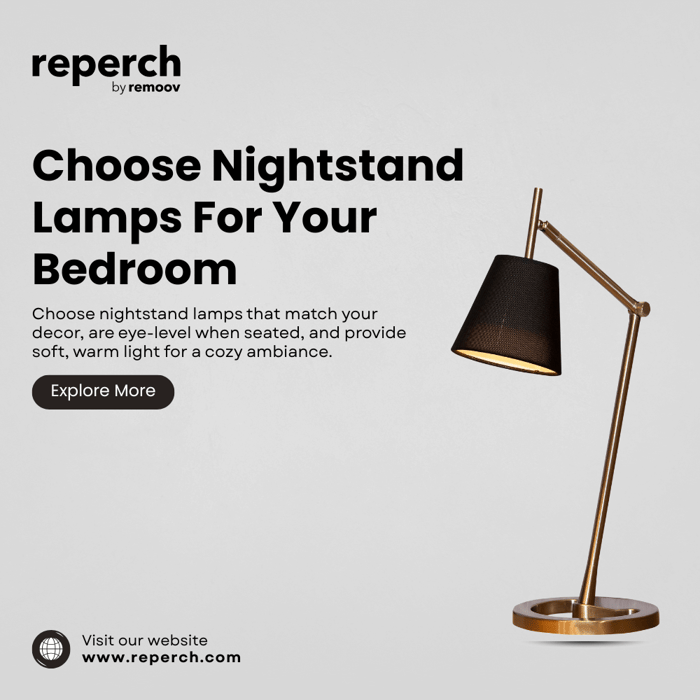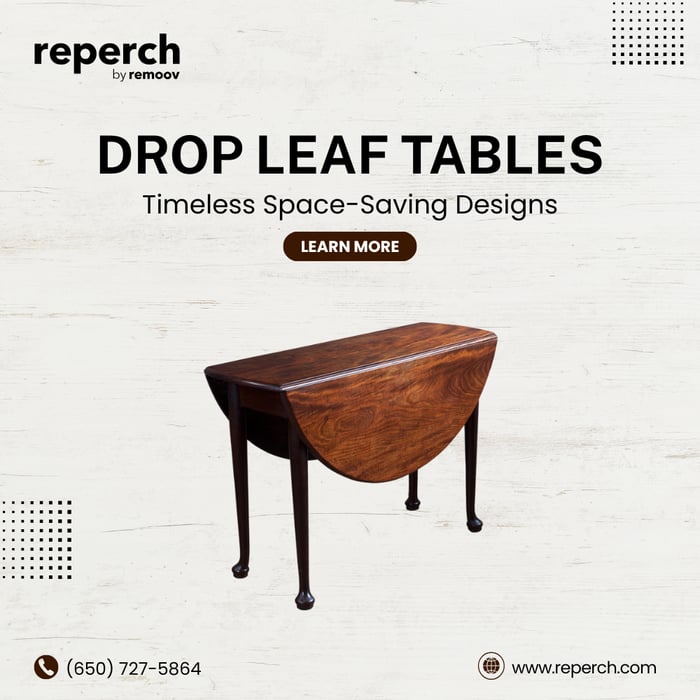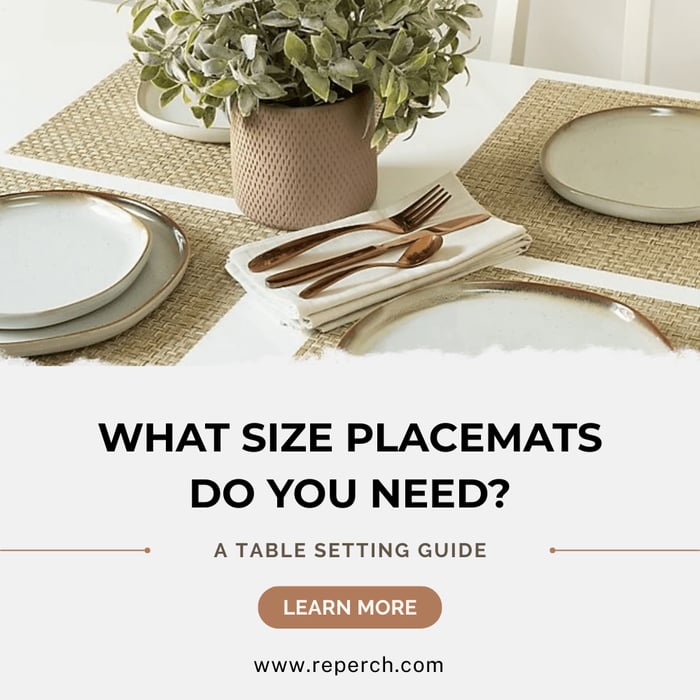Table of Contents
- Why Nightstand Lamps Matter
- 1. How Many Nightstand Lamps Do You Need?
- 2. Sizing Your Nightstand Lamp Correctly
- 3. Don’t Forget the Lampshade
- 4. Matching Lamp Styles to Bedroom Décor
- 5. Functional Considerations for Lighting
- 6. Placement and Clearance
- 7. Enhancing Mood with Lighting Layers
- 8. Choosing the Right Bulb
- 9. Matching Lamps to Secondhand or Vintage Nightstands
- Frequently Asked Questions
- Final Thoughts
Finding the right nightstand lamp is about more than just picking something that looks good. It’s about achieving the right balance between style and functionality, proportion and placement, lighting and ambiance. A well-chosen bedside lamp enhances your room’s aesthetics while providing the perfect glow for reading, relaxing, or winding down at the end of the day.
Whether you're styling a secondhand find from Reperch or looking to complement your vintage nightstand, this guide will walk you through everything you need to know about choosing the best nightstand lamps for your space.
Why Nightstand Lamps Matter
Nightstand lamps serve two main functions:
They provide practical lighting for activities like reading or checking your phone.
They enhance the visual balance and decor of your bedroom.
A mismatched or undersized lamp can throw off the entire room, while the right one ties everything together visually and functionally.
1. How Many Nightstand Lamps Do You Need?
If you're the only one sleeping in the bed, one nightstand lamp may be enough. But if you're sharing a queen or king-sized bed or just want a symmetrical look consider placing a lamp on each side.
General guidelines:
One lamp for solo sleepers or small rooms.
Two lamps for shared beds or large rooms for better balance and lighting control.
Having a lamp on each side offers personal lighting zones, especially helpful if your sleep schedules differ.
2. Sizing Your Nightstand Lamp Correctly
A key factor in choosing a lamp is proportion. It needs to relate properly to your nightstand, bed, and overall room size.
Lamp Height
The ideal height of a nightstand lamp depends on the height of your nightstand and mattress.
Rule of thumb:
Your lamp should be 2 to 3 inches taller than your nightstand.
If your nightstand is 24 inches high, look for a lamp around 26–27 inches tall.
For tall headboards or high ceilings, you can scale up with taller lamps.
When sitting up in bed, the bottom of the lampshade should align with your eye level typically 22–27 inches from your resting position.
Lamp Width
Width helps create balance with your nightstand’s surface area.
Rule of thumb:
Choose a lamp that’s around 1/3 the width of the nightstand at its widest point (usually the shade).
If your nightstand is 18 inches wide, a lamp that’s 6 inches wide at the base of the shade will feel proportionate.
3. Don’t Forget the Lampshade
The shape, size, and material of your lampshade can dramatically affect both appearance and lighting.
Shade Size
The height of the shade should be two-thirds the height of the lamp base.
The width of the shade should be twice the width of the lamp base.
These ratios keep your lamp visually balanced and avoid a top-heavy or underwhelming look.
Shade Material and Color
White or off-white shades provide the most light and work well for reading.
Colored or patterned shades add personality and soften the glow.
Natural fabrics like linen or rattan offer a warm, ambient light and textured appeal.
4. Matching Lamp Styles to Bedroom Décor
Whether your bedroom leans traditional, modern, eclectic, or vintage, there’s a lamp style that complements it.
Traditional Looks
Think of:
Candlestick-style bases
Ornate shades or metallic finishes
Tiffany-style stained glass
Modern Styles
Look for:
Clean lines
Matte or polished finishes
Neutral or bold colors
Eclectic or Vintage
Combine unexpected elements:
Mismatched base and shade
Antique ceramic with a contemporary drum shade
Statement designs that reflect your personality
At Reperch, you can often find unique secondhand lamps that bridge design eras and add one-of-a-kind charm.
5. Functional Considerations for Lighting
A lamp’s job is to light your space. Choose the right bulb, brightness, and controls for your lifestyle.
Reading Lamps
If you read in bed, aim for:
A lamp height that aligns with your eyes
A shade that diffuses light downward
Bulbs around 450–800 lumens for focused yet comfortable brightness
Ambient Lighting
If your lamp is your primary light source:
Choose a taller lamp to spread light farther
Use warm white LED bulbs (2700K–3000K) for a cozy, inviting glow
Dimmable Options
Adding a dimmer switch gives you full control over the brightness. It’s ideal for:
Adjusting light throughout the day
Creating a soft atmosphere at night
Reducing harsh lighting early in the morning
6. Placement and Clearance
Placement Height
The combined height of your lamp and nightstand should fall between 58 and 64 inches from the floor. This ensures the light is usable but not overpowering.
Mattress Clearance
Make sure the lamp is 19–21 inches above the top of the mattress to maintain enough space for turning pages or placing a glass of water.
Keep It Clutter-Free
Don’t let your lamp overcrowd the nightstand. You should still have room for essentials like books, phones, or decor items.
7. Enhancing Mood with Lighting Layers
For a truly functional and beautiful bedroom, use layers of light:
Ambient (general light): From a ceiling fixture or taller lamp
Task (focused light): From your nightstand lamp
Accent (decorative): From wall sconces, picture lights, or LED strips
Mixing these creates dimension and flexibility depending on time of day or activity.
8. Choosing the Right Bulb
Bulbs control the color, strength, and warmth of your lighting. Make the right pick based on your needs.
Bulb Types
LEDs: Energy-efficient and long-lasting
CFLs: Budget-friendly but less commonly used today
Incandescents: Traditional glow but higher energy use
Color Temperature (Kelvin Scale)
Warm white (2700K–3000K): Best for bedrooms
Cool white (3500K–4100K): Better for task-heavy areas
Daylight (5000K+): Too bright for relaxing spaces
9. Matching Lamps to Secondhand or Vintage Nightstands
If you’ve purchased a vintage or secondhand nightstand from Reperch, choosing the right lamp can help highlight its charm:
Antique wood pairs well with ceramic or brass bases
Mid-century styles suit minimalist lamps with globe or cone shades
Modern nightstands welcome geometric shapes or bold finishes
Let the nightstand’s texture, shape, and scale guide your lamp choice.
Frequently Asked Questions
What size lamp is best for a 24-inch nightstand?
A lamp around 26–27 inches tall will maintain proportion and visual harmony.
Do I need two lamps in the bedroom?
If you share the bed or want symmetry, two lamps one on each nightstand are recommended.
How do I match a lamp to a black nightstand?
Contrast works well. Try light-colored bases or metallic finishes like brass or nickel.
What’s the best light bulb for a cozy vibe?
Warm white LED bulbs (2700K) give off a soft, calming glow ideal for bedrooms.
Can I use mismatched lamps?
Yes, as long as they’re similar in height and scale. Mixing styles can add personality to your space.
Final Thoughts
Choosing the best nightstand lamp means finding the right mix of proportion, function, and style. Whether you’re outfitting a minimalist setup or designing around a vintage nightstand from Reperch, your lamp should feel like a natural part of the room visually balanced, practical, and aligned with your décor.
Use these measurements and styling tips to make sure your lamp doesn’t just light the room it completes it.








